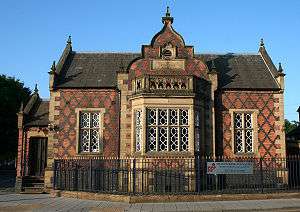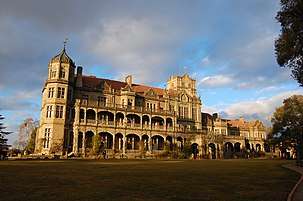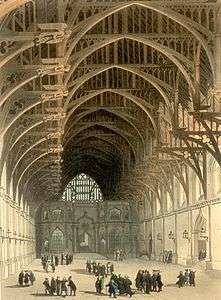Jacobethan
The Jacobethan or Jacobean Revival architectural style is the mixed national Renaissance revival style that was made popular in England from the late 1820s,[1] which derived most of its inspiration and its repertory from the English Renaissance (1550–1625), with elements of Elizabethan and Jacobean.
.jpg)

John Betjeman coined the term "Jacobethan" in 1933,[2] and described it as follows:
The style in which the Gothic predominates may be called, inaccurately enough, Elizabethan, and the style in which the classical predominates over the Gothic, equally inaccurately, may be called Jacobean. To save the time of those who do not wish to distinguish between these periods of architectural uncertainty, I will henceforward use the term "Jacobethan".[3]
The term caught on with art historians. Timothy Mowl asserts in The Elizabethan and Jacobean Style (2001) that the Jacobethan style represents the last outpouring of an authentically native genius that was stifled by slavish adherence to European baroque taste.
Architecture

In architecture the style's main characteristics are flattened, cusped "Tudor" arches, lighter stone trims around windows and doors, carved brick detailing, steep roof gables, often terra-cotta brickwork, balustrades and parapets, pillars supporting porches and high chimneys as in the Elizabethan style. Examples of this style are Harlaxton Manor in Lincolnshire (illustration), Mentmore Towers[4] in Buckinghamshire and Sandringham House in Norfolk, England.
In June 1835, when the competition was announced for designs for new Houses of Parliament, the terms asked for designs either in the Gothic or the Elizabethan style. The seal was set on the Gothic Revival as a national style, even for the grandest projects on the largest scale; at the same time, the competition introduced the possibility of an Elizabethan revival. Of the ninety-seven designs submitted, six were in a self-described "Elizabethan" style.[5]
In 1838, with the Gothic revival was well under way in Britain, Joseph Nash, trained in A.W.N. Pugin's office designing Gothic details, struck out on his own with a lithographed album Architecture of the Middle Ages: Drawn from Nature and on Stone in 1838. Casting about for a follow-up, Nash extended the range of antiquarian interests forward in time with his next series of lithographs The Mansions of England in the Olden Time 1839–1849, which accurately illustrated Tudor and Jacobean great houses, interiors as well as exteriors, made lively with furnishings and peopled by inhabitants in ruffs and farthingales, the quintessence of "Merrie Olde England". A volume of text accompanied the fourth and last volume of plates in 1849, but it was Nash's picturesque illustrations that popularised the style and created a demand for the variations on the English Renaissance styles that was the essence of the newly revived "Jacobethan" vocabulary.
Two young architects already providing Jacobethan buildings were James Pennethorne and Anthony Salvin, both later knighted. Salvin's Jacobethan Harlaxton Manor, near Grantham, Lincolnshire, its first sections completed in 1837, is the great example that defines the style.

The Jacobethan Revival survived the late 19th century and became a part of the commercial builder's repertory through the first 20 years of the 20th century. Apart from its origins in the United Kingdom, the style became popular both in Canada and throughout the United States during those periods, for sturdy "baronial" dwellings in a free Renaissance style. A key exponent of the style in Britain was T.G. Jackson. Some examples can also be found in buildings in the former British Empire, such as Rashtrapati Niwas, the Viceregal Lodge at Shimla in India.
Literature
The term has proved useful to literary studies that are emphasizing the continuity of English literature in the half century 1575–1625.[6] For example, the 1603 death of Elizabeth I falls in the middle of Shakespeare's career as dramatist: he is both an Elizabethan and a Jacobean writer.
References
- Newman and Pevsner 1972:55
- Betjeman, Ghastly Good Taste, 1933; Thomas Burns McArthur, Feri McArthur, eds. The Oxford companion to the English language, 1992:539.
- Betjeman, Ghastly Good Taste, London, Chapman and Hall, 1933 p 41
- Good Stuff IT Services (1951-09-26). "Mentmore Towers - Mentmore - Buckinghamshire - England". British Listed Buildings. Retrieved 2012-08-15.
- Pevsner 1962:477
- E.g. by S. Gorley Putt, reviewing works on Jacobethan drama in "Jacobethan wonderlands", The Sewanee Review 1976:699ff; "the revival of non-Shakespearean 'Jacobethan' plays has been particularly successful in two Elizabethan-style playhouses, the Swan at Stratford-upon-Avon and Shakespeare's Globe in London", observe Angela Stock and Ann-Julia Zwirerlein in D. Mehl and A. Stock, eds., Plotting Early Modern London: New Essays on Jacobean City Comedy, "Introduction: 'Our scene is London...'", 2004:1.
Sources and further reading
- Mowl, Tim (1993). Elizabethan And Jacobean Style. London: Phaidon Press. ISBN 0-7148-2882-3.
- Newman, John; Pevsner, Nikolaus (1972). Dorset. The Buildings of England. Harmondsworth: Penguin Books. p. 55. ISBN 0-14-071044-2.
- Pevsner, Nikolaus (1962). London. The Buildings of England. I. Harmondsworth: Penguin Books. p. 477.
